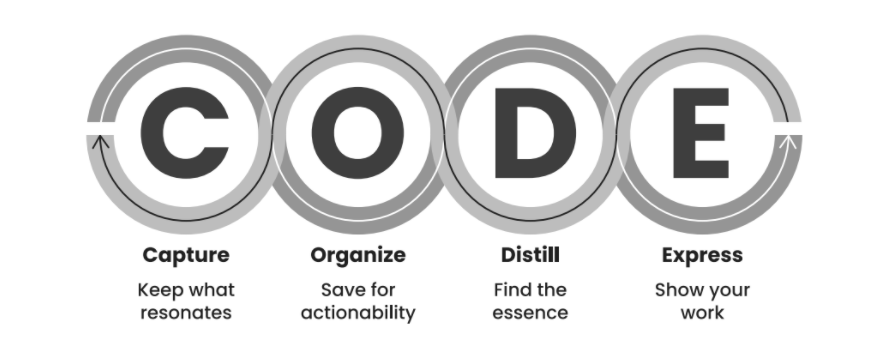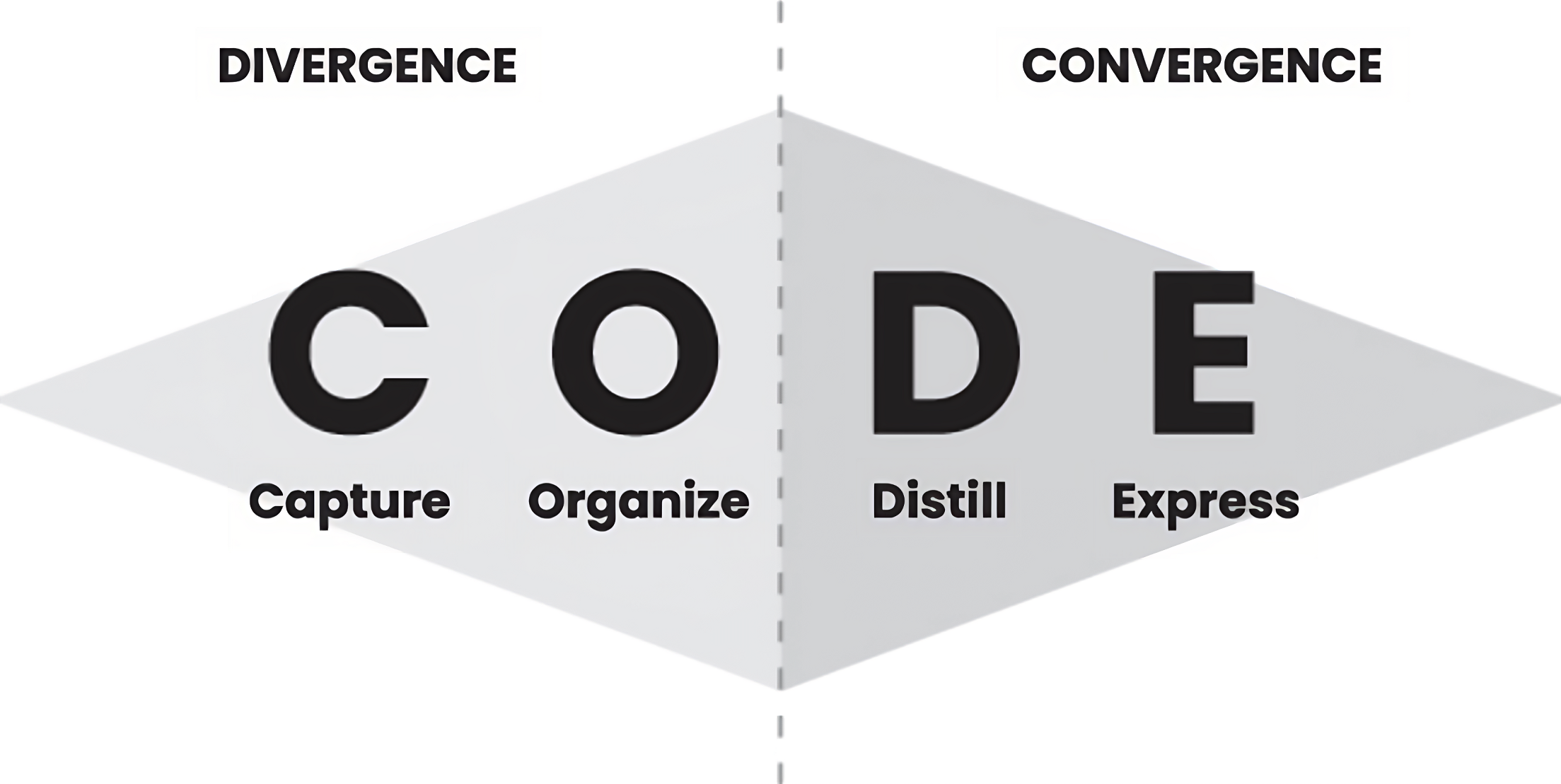Building a Second Brain is a book about notes, written by Tiago Forte in June 2022. It covers what Tiago believes to be a productive an useful way to take and use notes. I thoroughly enjoyed this book so below I'll share my summary.
What is a Second Brain?
Simply, a second brain is a place to store and organise your notes. It's place to make your ideas concrete. A place that reveals new associations between your ideas. And a place to incubate your ideas over time to sharpen your unique perspective.
Ideally notes added to your second brain should be useful to your future self. The book explains a method that helps make this a reality.
The CODE Method
Taking notes that remain useful over time isn't simple. It is hard to predict what future you will need. Tiago uses a 4 step method when taking and working with his notes to make them as useful as possible. It's called the CODE method.

Capture
The first step is to capture notes. It doesn't really matter what app you use. Just pick one and stick with it for 6 months before worrying about if it's the perfect one or not. Notes should be taken with a curator mindset. If you capture every interesting thing you see, you may as well capture nothing. Instead take notes about things that resonate with you. Don't think too hard about it. This gets easier with practice.
Tiago recommends having a note inbox where unprocessed notes go. That way you can quickly capture notes when working without having to break your flow to figure out where to put it.
Organise
Step 2 is organising your notes by actionability using the PARA system. Start by creating 4 folders:
- Projects
- Areas
- Resources
- Archive
Projects should contain a folder for each project you are currently working on. A project is defined as some piece of work with an end date. Something that has a stopping point. For example, writing an article, recording a Youtube video or putting a slide deck together.
Areas are for ongoing projects; things that you need to work on or maintain that don't have an end date lined up. Maintaining your home, the relationship with your partner or fitness for example. Create a folder for each area in your life you want to take notes on.
Resources are similar areas, except there is no maintenance involved. This is where you would take notes on things you are interested in. This is where I store notes on reading, philosophy and money etc.
Finally, the archive folder is for what it sounds like. When you finish a project, move it to the archive. If an area is no longer something you are maintaining move to it the archive too. The archive gets these notes and folders out of your way, but the notes will always be there if you need them or if circumstances change.
By storing your notes this way you optimise for action. After all you're probably not taking notes for the sake of it. You do it to get things done. So when you're processing your notes inbox, start by checking your projects folder. If there is a pending project where the note is relevant place it there. If not, check your areas folder. If you haven't got a project or an area that the note would be useful for, put it in a folder in your resources. Don't worry too much about getting this right, search is your friend.
Your notes should now be in the folder where they are most likely to be useful to you when you need them.
Distill
Distilling your notes is the process of making them scannable. You want to have notes that a busy future you will find useful. Tiago uses a process called “Progressive Summarisation”. Your notes should be reasonably concise to begin with. However, you want to make sure that you can get the essence of a note in just a few seconds. Progressive summarisation starts with bolding the most important parts of a note. Then highlight the the most important bolded parts. Finally, for longer notes, you write a short summary.
The time to do this summarisation isn't when you capture or organise the note, but when you next use it in a project or for some other output. At the point you'll be in the best place to know what parts of the note are the most valuable.
Express
We have our notes, they're organised by actionability and it's easy to see what the most valuable part of each note is. It's time to put them to work. Modern work is more hectic and fragmented than ever before, so it's important to find a way to be productive despite this. An effective technique is to work on “Intermediate Packets”. These are small chunks of complete work that can be composed into larger projects. Here are a few examples of what an intermediate packet might be. A summary note combining and refining other notes, an outline of the article you want to write or your initial plan for a remodel you want to do in your kitchen.
An intermediate packet is something you can complete in ~20 mins or so. One of the benefits of working in small complete chunks is that you can share early and often. Feedback is a great way to improve the work we produce.
Creating intermediate packets provides an opportunity to use existing notes. Check the project folder for anything that might be relevant. Take a look in your other folders too and make use of search. If you find relevant notes, move them to the project folder. Use them as your reference material. This is also a good time to progressively summarise the notes you use.
A completed project is now just a case of combining and organising intermediate packets.
The Creative Process
The way we make and create is always changing but the creative process itself is ancient. We gather info, learn new things or look at them from a different perspective, then we combine those things into something new. We strip away the good to surface the great.
This is a process of divergence then convergence. First you explore all options to see what works and what doesn't. Make prototypes, first drafts, outlines etc. Then it's time to refine and focus in on the best parts. The CODE system builds on this process. Capturing and Organising notes is divergence. Distilling and Expressing is Convergence.

Techniques for Getting Work Done
Tiago mentions a few mentions a few techniques he uses when trying to complete a piece of work.
The Archipelago of ideas
When all of your research is complete and it's time to do the work it is useful to gather the most salient ideas into one document. This can include highlights from notes, images or anything else that will help produce the final piece of work. Reorder and add to these highlights until you end up with an outline of the final project. It is a lot easier to get started when you're not starting from a blank page.
Hemingway Bridges
When Ernest Hemingway was writing, he'd never finish a session until he knew what he'd write next. He would take notes about what he had planned and leave them for the next session. When he started his next session he'd know exactly where to begin. This is a great way to use yesterday's momentum today.
Reducing the Scope
This is a common technique in agile software development. You assign a time budget to a task and when the time is up, you ship what you've done. If you're running out of time on a project and there is risk you won't finish, reduce the scope of the project. The parts that don't make the cut can always be added later or be the basis of a new project. It is better to share a smaller completed project with the world than have an incomplete masterpiece that never sees the light of day.
Conclusion
I really enjoyed this book. If you're the kind of person that enjoys productivity systems, you probably will too. If you want to find out more, check out the Building a Second Brain Website I've implemented most of the recommendations this book makes and I'll report back in a few months with how I've faired.